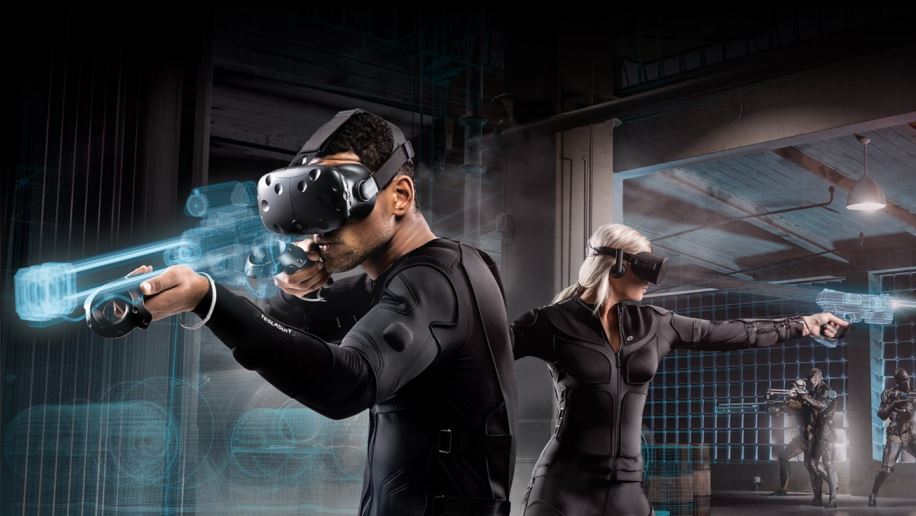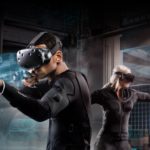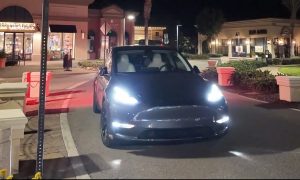

News
Virtual reality haptic “smart suit” uses AI with biometrics to simulate real-world environments
One of the innovative future technologies that was on display at this year’s Consumer Electronics Show (CES 2019) in Las Vegas is the Teslasuit, a full body virtual reality haptic suit that delivers real sensations to users that mimic the environment of a digital simulation or game. In a haptic feedback system, stimuli are used to provoke real sensations involving touch – shocks, punches, pushes, bumps, etc. Teslasuit combines this sort of environmental feedback along with climate control, motion capture, and biometric systems to give a fully responsive, immersive experience to the user. Combined with true-to-life virtual reality graphics, this device could finally provide the experience VR was intended to have since its development began.
The full-body sensations of the Teslasuit seem to indicate a new level of experience for virtual reality users, but the haptic capabilities aren’t the only things making it stand out. The suit’s biometric system is designed to use machine learning to analyze heart rate, stress levels, and overall mental and emotional states to create experiences catered to the user. How this capability will be implemented is really up to game developers, though. As data is gathered from biometrics, capabilities will follow. “This is very important for the gaming industry. We see that in the future, when we come to the end user market, that we will be able to offer a lot of data sensing for the developers to process, for the AI itself to adjust the game to the player,” Dimitri Mikhalchuk, co-founder of Teslasuit, explained in an interview with Digital Trends. The suit was first officially unveiled at CES 2018.
Teslasuit uses 68 channels embedded throughout the suit’s fabric to deliver electrical stimulations, and the company is working to expand on that number. Also included in the suit’s software is a haptic library, enabling game developers to create their own effects to correspond with their virtual worlds. The climate control system adjusts the temperature of the suit, heating and cooling in accordance with the virtual environment. Finally, its motion capture and avatar system track motions from the users entire body to interact with virtual environments (and built with multiple players in mind), something that’s more or less an expansion on the core of VR to begin with.
- The haptic Teslasuit as imagined in a VR game environment. | Credit: Teslasuit
- The haptic Teslasuit. | Credit: Teslasuit
- The haptic Teslasuit. | Credit: Teslasuit
While the Teslasuit brings virtual worlds closer to a potentially action-packed reality, bruises are not part of the experience, according to Mikhalchuk. The electric stimulation is matched to the users own strength, adapting its responses to the input. In other words, the force a user “hits” with in a game is the amount of force used to “hit” back, i.e., electric pulses make the muscles contract within that range.
With the equivalent of a full body shocking device wrapped around players, the question of security arises, yet another thing Teslasuit has addressed in its design. Its software has military grade encryption (AES 256) built into its wireless control system to ensure users’ bodies are not (literally) hacked into. Among its many features, Teslasuit is also completely wireless, boasts a 10+ hour battery life, and is machine washable (important for sweat-inducing virtual scenarios and general funk from frequent wear). A summary of the device on the Teslasuit website reads like something from a science fiction movie:
A highly developed form of computer modeling allows an operator to immerse in the artificial world. The user can act directly in it with the help of special sensory devices that link movements with audio-visual effects. In this case, the user’s visual, auditory, tactile, and motor sensations are replaced by their imitation, generated by a computer system with full body haptic VR suit. At the same time, biometric system of the Teslasuit analyzes human performance and health (workforce and human performance analytics). – Teslasuit.io
The future of augmented reality and virtual reality applications have been explored in fictional storylines over the years with the most recent and directly relevant one being the haptic system imagined in the movie Ready Player One. The Battlestar Galactica prequel series “Caprica” also imagined an immersive virtual world that users could “feel” experiences in (or otherwise do things they wouldn’t/couldn’t in the real world), but that didn’t require a suit, just a mind. In an episode of Netflix’s Black Mirror series called “Playtest”, an American traveler in the UK signs up to demo an immersive VR horror game to earn some money. Unlike the Teslasuit, however, the experience in that episode involved an implant to the user’s neck called a “mushroom” which linked up the VR experience with a user’s brain. The Matrix also suggested an immersive environment, although people weren’t exactly voluntarily involved, if they ever knew it wasn’t real to begin with.
Other than gaming, Teslasuit is suggestive of several solutions for non-entertainment industries. According to an article on their company website, several VR-training solutions were available for demonstration at CES 2019: Astronaut VR-training in an ISS module, an oil-loading ramp operation VR-simulator, emergency evacuation VR-training, and a powerplant VR training simulator. Teslasuit is currently continuing its outreach and collaboration with game companies to develop content. Its software development kit and corresponding system tools and applications are included with the purchase of the suit which began shipping B2B in the third quarter of 2018.
Watch the below video for a first-hand review of Teslasuit:
Elon Musk
Tesla investors will be shocked by Jim Cramer’s latest assessment
Jim Cramer is now speaking positively about Tesla, especially in terms of its Robotaxi performance and its perception as a company.

Tesla investors will be shocked by analyst Jim Cramer’s latest assessment of the company.
When it comes to Tesla analysts, many of them are consistent. The bulls usually stay the bulls, and the bears usually stay the bears. The notable analysts on each side are Dan Ives and Adam Jonas for the bulls, and Gordon Johnson for the bears.
Jim Cramer is one analyst who does not necessarily fit this mold. Cramer, who hosts CNBC’s Mad Money, has switched his opinion on Tesla stock (NASDAQ: TSLA) many times.
He has been bullish, like he was when he said the stock was a “sleeping giant” two years ago, and he has been bearish, like he was when he said there was “nothing magnificent” about the company just a few months ago.
Now, he is back to being a bull.
Cramer’s comments were related to two key points: how NVIDIA CEO Jensen Huang describes Tesla after working closely with the Company through their transactions, and how it is not a car company, as well as the recent launch of the Robotaxi fleet.
Jensen Huang’s Tesla Narrative
Cramer says that the narrative on quarterly and annual deliveries is overblown, and those who continue to worry about Tesla’s performance on that metric are misled.
“It’s not a car company,” he said.
He went on to say that people like Huang speak highly of Tesla, and that should be enough to deter any true skepticism:
“I believe what Musk says cause Musk is working with Jensen and Jensen’s telling me what’s happening on the other side is pretty amazing.”
Tesla self-driving development gets huge compliment from NVIDIA CEO
Robotaxi Launch
Many media outlets are being extremely negative regarding the early rollout of Tesla’s Robotaxi platform in Austin, Texas.
There have been a handful of small issues, but nothing significant. Cramer says that humans make mistakes in vehicles too, yet, when Tesla’s test phase of the Robotaxi does it, it’s front page news and needs to be magnified.
He said:
“Look, I mean, drivers make mistakes all the time. Why should we hold Tesla to a standard where there can be no mistakes?”
It’s refreshing to hear Cramer speak logically about the Robotaxi fleet, as Tesla has taken every measure to ensure there are no mishaps. There are safety monitors in the passenger seat, and the area of travel is limited, confined to a small number of people.
Tesla is still improving and hopes to remove teleoperators and safety monitors slowly, as CEO Elon Musk said more freedom could be granted within one or two months.
News
Tesla launches ultra-fast V4 Superchargers in China for the first time
Tesla has V4 Superchargers rolling out in China for the first time.

Tesla already has nearly 12,000 Supercharger piles across mainland China. However, the company just initiated the rollout of the ultra-fast V4 Superchargers in China for the first time, bringing its quick-charging piles to the country for the first time since their launch last year.
The first batch of V4 Superchargers is now officially up and running in China, the company announced in a post on Chinese social media outlet Weibo today.
The company said in the post:
“The first batch of Tesla V4 Superchargers are online. Covering more service areas, high-speed charging is more convenient, and six-layer powerful protection such as rain and waterproof makes charging very safe. Simultaneously open to non-Tesla vehicles, and other brands of vehicles can also be charged. There are more than 70,000 Tesla Superchargers worldwide. The charging network layout covers 100% of the provincial capitals and municipalities in mainland China. More V4 Superchargers will be put into use across the country. Optimize the charging experience and improve energy replenishment efficiency. Tesla will accompany you to the mountains, rivers, lakes, and seas with pure electricity!”
The first V4 Superchargers Tesla installed in China are available in four cities across the country: Shanghai, Zhejiang, Gansu, and Chongqing.

Credit: Tesla China
Tesla has over 70,000 Superchargers worldwide. It is the most expansive and robust EV charging network in the world. It’s the main reason why so many companies have chosen to adopt Tesla’s charging connector in North America and Europe.
In China, some EVs can use Tesla Superchargers as well.
The V4 Supercharger is capable of charging vehicles at speeds of up to 325kW for vehicles in North America. This equates to over 1,000 miles per hour of charging.
Elon Musk
Elon Musk hints at when Tesla could reduce Safety Monitors from Robotaxi
Tesla could be reducing Safety Monitors from Robotaxi within ‘a month or two,’ CEO Elon Musk says.

Elon Musk hinted at when Tesla could begin reducing Safety Monitors from its Robotaxis. Safety Monitors are Tesla employees who sit in the front passenger seat during the driverless rides, and are there to ensure safety for occupants during the earliest rides.
Tesla launched its Robotaxi fleet in Austin last Sunday, and after eight days, videos and reviews from those who have ridden in the driverless vehicles have shown that the suite is safe, accurate, and well coordinated. However, there have been a few hiccups, but nothing that has put anyone’s safety in danger.
A vast majority — close to all of the rides — at least according to those who have ridden in the Robotaxi, have been performed without any real need for human intervention. We reported on what was the first intervention last week, as a Safety Monitor had to step in and stop the vehicle in a strange interaction with a UPS truck.
Watch the first true Tesla Robotaxi intervention by safety monitor
The Tesla and UPS delivery truck were going for the same street parking space, and the Tesla began to turn into it. The UPS driver parallel parked into the spot, which was much smaller than his truck. It seemed to be more of an instance of human error instead of the Robotaxi making the wrong move. This is something that the driverless cars will have to deal with because humans are aggressive and sometimes make moves they should not.
The Safety Monitors have not been too active in the vehicles. After all, we’ve only seen that single instance of an intervention. There was also an issue with the sun, when the Tesla braked abnormally due to the glare, but this was an instance where the car handled the scenario and proceeded normally.
With the Robotaxi fleet operating impressively, some are wondering when Tesla will begin scaling back both the Safety Monitors and Teleoperators that it is using to ensure safety with these early rides.
CEO Elon Musk answered the inquiry by stating, “As soon as we feel it is safe to do so. Probably within a month or two.”
As soon as we feel it is safe to do so.
Probably within a month or two. We continue to improve the Tesla AI with each mile driven.
— Elon Musk (@elonmusk) June 30, 2025
Musk’s response seems to confirm that there will be fewer Teleoperators and Safety Monitors in the coming months, but there will still be some within the fleet to ensure safety. Eventually, that number will get to zero.
Reaching a point where Tesla’s Robotaxi is driverless will be another significant milestone for the company and its path to fully autonomous ride-sharing.
Eventually, Tesla will roll out these capabilities to consumer-owned vehicles, offering them a path to generate revenue as their car operates autonomously and completes rides.
For now, Tesla is focusing on perfecting the area of Austin where it is currently offering driverless rides for just $4.20 to a small group of people.
-

 News5 days ago
News5 days agoTesla Robotaxi’s biggest challenge seems to be this one thing
-

 News2 weeks ago
News2 weeks agoTesla confirms massive hardware change for autonomy improvement
-

 Elon Musk2 weeks ago
Elon Musk2 weeks agoElon Musk slams Bloomberg’s shocking xAI cash burn claims
-

 News2 weeks ago
News2 weeks agoTesla China roars back with highest vehicle registrations this Q2 so far
-

 News2 weeks ago
News2 weeks agoTesla features used to flunk 16-year-old’s driver license test
-

 News2 weeks ago
News2 weeks agoTexas lawmakers urge Tesla to delay Austin robotaxi launch to September
-

 News2 weeks ago
News2 weeks agoTesla dominates Cars.com’s Made in America Index with clean sweep
-

 News2 weeks ago
News2 weeks agoTesla’s Grok integration will be more realistic with this cool feature























